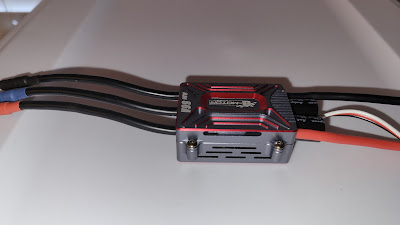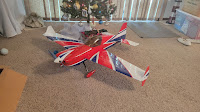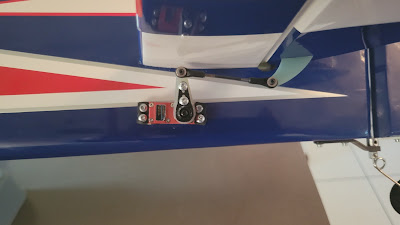First, apologies for running a little late on the report. Life kind of got in the way.
The T Motor has a huge advantage of not only having more power but can also run a 13/6.5 prop. These are both the holy grails of power systems, and the T Motor delivers on both. Of course, you have to pay for that somehow, and higher amp draw is the price. However, this was not as severe as I was expecting. I usually come down with 15 volts in the pack after 4.5 minutes, and with the T Motor (which you can see I ran pretty hard) it was 14.8, That's the drop dead figure for quitting on a 4s pack, so we essentially gave up nothing. Not being an engineer or anything, my guess is the motor is simply ten years newer technology and more efficient.
Starting at the beginning, the entire product presentation is superb. The boxes are really nice, and that's important because we always need boxes to store and organize our stuff.
The motor itself is beautifully made, utterly beautiful. It's honestly as beautiful as a Torque.
The part that really impressed me was the ESC. The entire unit is metal encased. This will make it more durable if you ever shove the motor back into the battery compartment or other abusive behavior.
You can see they paid a lot of attention to cooling the ESC with a plethora of slots.
It also has a really super nice feature of having a slot for the securing zip tie to slide through, On the older heat shrunk units, I hated to crank down on the zip tie too much for fear of crushing something important. With the slot, you just nail it down so it can never move.
One nice advantage on this ESC is the wires to the battery are a little longer. This gives you more flexibility to move the ESC forward or aft and gives you one more tool for adjusting the CG.
I had to shave the X Mount down a little but that was a 5-minute job. Outside of that it bolted right on, I believe the unit weighs about the same as the 2814/Airboss combo because my CG didn't change. This was a pretty seamless transition, which is always nice when you are trying something new.
Final thoughts on the motor and ESC themselves is how overwhelmingly nice they are. Of course, we still have to run it, but when stuff is this well made you go in with a really solid degree of confidence.
It's an extremely nice looking package.
FLYING
First, a few excuses. I had to order a programming cable, so for now I am flying the servos on 6 volts. These are 8 volt servos and much happier on the proper voltage. I could tell a difference, but I've been flying fast servos for years. I don't think most people would have noticed. This part will get better when I get my cable and can ram it up to 8 volts.
We're also coming off the back of a horrid cold front and the wind was terrible, choppy and gusty. Since the report is running a little late, it would have been a bad time to tear up a plane, so we settled for just running it hard and not trying to do something stupid in bad conditions.
A few really important things to notice here. I have often said nothing is as smooth as a Torque, but this T Motor is even better. It has it's own sound. This thing runs like a stick of butter.
Power is what most people want to hear about, and I am guesstimating we've got about 20% more. Next time out I will run a complete amps/watts test. We were just so excited to fly it that we forgot! You can check the video for yourself, but this motor blasts of a hover like a Saturn 5 and rockets down the runway like a 60" EXP. Power boarders on being a little too much, but most people like that anyway. In no way will anyone ever be disappointed in this motor's power output.
Of course, there's a price to pay for everything and with this motor it's a slight reduction in flight time. In my case, I usually come down after 4.5 minutes with 15.0 volts in the pack, and with the 480 I get 14.8. Of course, we ran the motor especially hard, and 14.8 is where you want to quit anyway. This is such a small difference I have no explanation other than the newer motor has 10 more years of development behind it and is more efficient. Then again, remember, I am not an engineer. Technically, I am a fun specialist.
Also, a big improvement is you can run a 13/6.5 prop instead of a 12/6. An inch is not that much on a ruler, but on a prop, it is day and night. Post stall just became so much easier. This is sort of what we experienced on the 52" planes with their massive 15" props. The planes actually fly lighter than they really are because that extra inch blows a lot of air over the lifting surfaces.
There's more to a motor than brute power though. You want a nice, linear throttle response. Previously the Airboss gave us that, but with the T motor it's much easier to modulate the throttle to get you exactly what you want. When you combine the extra control the bigger prop gives you with a smoother power delivery, that's a 360 win.
I have a little mechanical sympathy and I know when I have got something good in my hands. I ran it up at home to make sure it turned the right direction and right then I could tell I was going to be pleased. I noticed how quiet and smooth it ran just taxiing out. Once I worked the throttle a few times I knew I was not going to have any reliability issues because it was just too damm sweet for that.
These are just the observations on day one and in bad conditions. I will probably come back and add more observations as I fly it more, Still, to walk away this happy made for a pretty good day.
Nail
Where does this leave the Torque and Airboss series? While no longer the latest and greatest, that's still a valid system. Reliability and durability never go out of style. I think the fact this series has lasted 15 years in an ever-changing market with technology exploding shows how far ahead Torque was. We had a hell of a run with those motors, and they aren't done yet. If you have a Torque system, just
run the crap out of it. It's paid for and the performance was good enough yesterday.
What does this do to the 48" market though? I say it's probably the same thing as has happened with mega servos and Auras. T Motor is the next level up on the technology ladder, just like those other things. The Aura was enough to send the 48s to that next level of performance and then the mega servos made just as much difference. After two flights it's a little early to say T Motor is going to redefine this division, but I am certainly leaning that way.
So now a 48" can be whatever you want it to be. On one hand it's not that expensive to tweak one completely out with the most mega equipment available. Some of us are such performance nuts that we are seeking any advantage we can find. OTOH, not everyone wants or needs a plane that is this razor precise, and those folks can get still get away with the older equipment and never feel like they are missing a thing.
You can probably still get away with less expensive servos and no Aura. You can still have joyful flights with any number of power systems, and you can still fly a 48" strictly for sport. The 48s have always been that well rounded. The big difference is now we have the equipment we need to extract all the performance that has always been in these planes.
With the V2 treatment and better equipment, the Extra became a different plane. A fully tweaked out 48" is now more like a starship than a model plane. The V2 treatment stiffened up the entire plane, the servos center so well that superb tracking is guaranteed, and having the stability provided by the Aura makes these planes far more serious than we could foresee. With the T Motor we add more power and more prop, both winning strategies. Smoother running and more linear throttle response is another bonus.
I have gone through this in the four stages of V2 construction, mega servos, Auras and now T Motors. Each new piece of equipment made for a quantum leap in performance and this T Motor is no different. The equipment has finally (maybe) caught up with the advanced nature of the 48" Extra. Of course, it remains to be seen how the Edge and MXS respond to more power, smoother delivery and big prop, but it certainly woke my Extra up in no uncertain terms.






























































